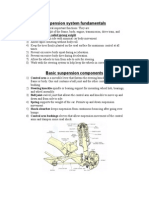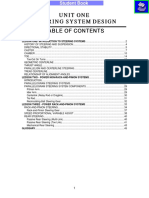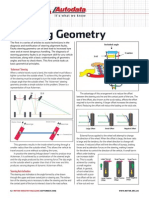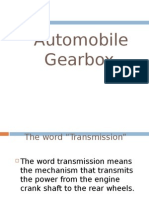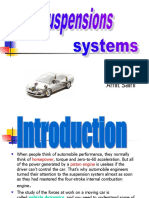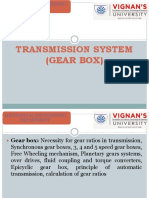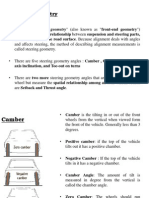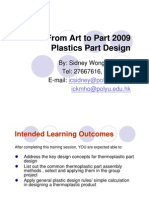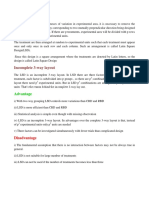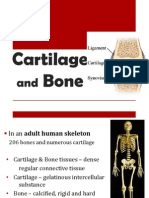100%(1)100% found this document useful (1 vote)
235 viewsWheel Alignment Principles
Wheel Alignment Principles
Uploaded by
Alex MTBA wheel alignment adjusts the suspension and steering angles to ensure proper vehicle handling with minimal tire wear. The factory initially sets the alignment angles, but over time and miles of driving, the angles can change slightly. An alignment checks and adjusts if needed both the front and rear wheel angles, including camber, caster, toe, steering axis inclination and included angle. Incorrect alignment angles can cause problems like tire wear, pulling, and wandering.
Copyright:
© All Rights Reserved
Available Formats
Download as PDF, TXT or read online from Scribd
Wheel Alignment Principles
Wheel Alignment Principles
Uploaded by
Alex MTB100%(1)100% found this document useful (1 vote)
235 views47 pagesA wheel alignment adjusts the suspension and steering angles to ensure proper vehicle handling with minimal tire wear. The factory initially sets the alignment angles, but over time and miles of driving, the angles can change slightly. An alignment checks and adjusts if needed both the front and rear wheel angles, including camber, caster, toe, steering axis inclination and included angle. Incorrect alignment angles can cause problems like tire wear, pulling, and wandering.
Original Description:
Wheel Alignment Principles
Copyright
© © All Rights Reserved
Available Formats
PDF, TXT or read online from Scribd
Share this document
Did you find this document useful?
Is this content inappropriate?
A wheel alignment adjusts the suspension and steering angles to ensure proper vehicle handling with minimal tire wear. The factory initially sets the alignment angles, but over time and miles of driving, the angles can change slightly. An alignment checks and adjusts if needed both the front and rear wheel angles, including camber, caster, toe, steering axis inclination and included angle. Incorrect alignment angles can cause problems like tire wear, pulling, and wandering.
Copyright:
© All Rights Reserved
Available Formats
Download as PDF, TXT or read online from Scribd
Download as pdf or txt
100%(1)100% found this document useful (1 vote)
235 views47 pagesWheel Alignment Principles
Wheel Alignment Principles
Uploaded by
Alex MTBA wheel alignment adjusts the suspension and steering angles to ensure proper vehicle handling with minimal tire wear. The factory initially sets the alignment angles, but over time and miles of driving, the angles can change slightly. An alignment checks and adjusts if needed both the front and rear wheel angles, including camber, caster, toe, steering axis inclination and included angle. Incorrect alignment angles can cause problems like tire wear, pulling, and wandering.
Copyright:
© All Rights Reserved
Available Formats
Download as PDF, TXT or read online from Scribd
Download as pdf or txt
You are on page 1of 47
At a glance
Powered by AI
The key takeaways are that a wheel alignment adjusts the suspension and steering angles to ensure proper vehicle handling and minimize tire wear. The main angles checked during an alignment are camber, caster, toe, included angle and scrub radius.
The main alignment angles that are checked and adjusted during a wheel alignment are camber, caster, toe, included angle and scrub radius. Camber is the tilt of the wheels from vertical. Caster is the tilt of the steering axis. Toe is the angle between the wheels. Included angle is camber plus steering axis inclination. Scrub radius affects handling.
Some common symptoms that could indicate an alignment issue are excessive tire wear, a pull to one side when driving straight, wander, and tire squeal during turns. A pull is felt as a tug on the steering wheel to one side. Wander is the vehicle not tracking in a straight line.
Wheel Alignment Principles
A wheel alignment is the adjustment of the suspension
and steering to ensure proper vehicle handling with
minimum tire wear.
When a vehicle is new, the alignment angles are set at the
factory. After many miles and/or months of driving, the
alignment angles can change slightly.
By adjusting the suspension and steering components,
proper alignment angles can be restored. An alignment
includes checking and adjusting, if necessary, both
front and rear wheels.
ALIGNMENT-RELATED PROBLEMS
• Most alignment diagnosis is symptom-based
diagnosis. The problem with the alignment is
determined from symptoms such as excessive tire
wear or a pull to one side of the road.
Pull Defined as a definite tug on the steering
wheel or pull toward the left or the right while
driving straight on a level road.
• Bent, damaged, worn suspension and/or steering
components or tire problems can cause this.
Wander
• Worn suspension and/or steering components are the
likely cause of this condition. Incorrect or unequal
alignment angles such as caster and toe, as well as
defective tire(s), can cause this condition
Camber
• Camber is the inward or outward tilt of the wheels
from true vertical as viewed from the front or rear of
the vehicle.
Positive camber. The solid Negative camber. The solid
Zero camber..
vertical line represents true vertical line represents true
vertical; the dotted line the vertical; the dotted line the
angle of the tire angle of the tire.
Excessive positive camber causes scuffing and
wear on the outside edge of the tire.
Excessive negative camber causes scuffing and wear on
the inside edge of the tire
Camber can cause pull if it is unequal side-to-side. A difference
of more than 1/2 degree from one side to the other will cause the
vehicle to pull.
The vehicle will pull toward the side with the most positive
camber.
• Incorrect camber can cause excessive wear on wheel
bearings.
Many vehicle manufacturers specify positive camber
so the vehicle’s weight is applied to the larger inner
wheel bearing and spindle.
As the vehicle is loaded or when the springs sag,
camber usually decreases. If camber is kept positive,
the running camber is kept near zero degrees for best
tire life.
Camber is not adjustable on many vehicles.
If camber is adjustable, the change is made by moving
the upper or the lower control arm or strut assembly by
means of one of the following methods:
a. Shims
b. Eccentric cams
c. Slots
• Camber should be equal on both sides; however, if
camber cannot be adjusted exactly equal, make
certain that there is more camber on the front of the
left side to help compensate for the road crown (1/2
degree maximum difference).
Caster
• Caster is the forward or rearward tilt of the steering
axis in reference to a vertical line as viewed from the
side of the vehicle.
• The steering axis is defined as the line drawn through
the upper and lower steering pivot points.
• Zero caster means the steering axis is straight up and
down.
• On an SLA suspension system, the upper pivot is the
upper ball joint and the lower pivot is the lower ball
joint.
On a MacPherson strut system, the upper pivot is the
center of the upper bearing mount and the lower pivot
point the lower ball joint.
• Positive (+) caster is present when the upper
suspension pivot point is behind the lower pivot point
(ball joint) as viewed from the side.
• Negative (–) caster is present when the upper
suspension pivot point is ahead of the lower pivot
point (ball joint) as viewed from the side.
Caster is not a tire-wearing angle, but positive caster
does cause changes in camber during a turn.
• Caster is a stability angle
• If caster is excessively positive, the vehicle steering will be
very stable (will tend to go straight with little steering wheel
correction needed). This degree of caster helps with steering
wheel returnability after a turn.
• If the caster is positive, steering effort will increase with
increasing positive caster. Greater road shocks will be felt
by the driver when driving over rough road surfaces.
• If caster is negative, or excessively unequal, the vehicle will
not be as stable and will tend to wander (constant steering
wheel movement will be required to maintain straight-ahead
direction). If a vehicle is heavily loaded in the rear, caster
increases
• Caster can cause pull if unequal; the vehicle will pull
toward the side with the least positive caster. The pulling
force of unequal caster is only about one-fourth the pulling
force of camber.
• Caster is not adjustable on many vehicles.
• If caster is adjustable, it is changed by moving the lower or
the upper pivot point forward or backward by means of the
following:
a. Shims
b. Eccentric cams
c. Slots
d. Strut rods
• Caster should be equal on both sides; however, if
caster cannot be adjusted to be exactly equal, make
certain that there is more caster on the right side
(maximum 1/2-degree difference) to help compensate
for the crown of the road.
Toe
• Toe is the difference in distance between the front and
rear of the tires
• As viewed from the top of the vehicle (a bird’s eye
view), zero toe means that both wheels on the same
axle are parallel.
• Toe is also described as a comparison of horizontal
lines drawn through both wheels on the same axle
• If the front of the tires is closer than the rear of the
same tires, then the toe is called toe-in or positive (+)
toe
• If the front of the tires is farther apart than the rear of
the same tires, then the wheels are toed-out, or have
negative (–) toe.
• The purpose of correct toe setting is to provide
maximum stability with a minimum of tire wear when
the vehicle is being driven.
• Toe is measured in fractions of degrees or in
millimeters (mm).
• Incorrect toe is the major cause of excessive tire
wear!
• If not correct, toe causes camber-type wear on
one side of the tire.
Incorrect front toe does not cause a pull condition.
Incorrect toe on the front wheels is split equally
as the vehicle is driven because the forces acting
on the tires are exerted through the tie rod and
steering linkage to both wheels.
Incorrect (or unequal) rear toe can cause tire wear.
If the toe of the rear wheels is not equal, the
steering wheel will not be straight and will pull
toward the side with the most toe-in.
• Normal wear to the tie rod ends and other steering
linkage parts usually causes toe-out.
Excessive front toe-out will cause wander (lack of
directional stability), especially during braking.
Incorrect toe will cause an uncentered steering wheel.
If toe is unequal in the rear, the vehicle will pull
toward the side with the most toe-in.
STEERING AXIS INCLINATION (SAI)
• The steering axis is the angle formed between true
vertical and an imaginary line drawn between the
upper and lower pivot points of the spindle.
Steering axis inclination (SAI) is the inward tilt
of the steering axis. SAI is also known as kingpin
inclination (KPI) and is the imaginary line drawn
through the kingpin as viewed from the front.
SAI is also called ball joint inclination (BJI), if
SLA-type suspension is used, or MacPherson
strut inclination (MSI).
• The SAI provides an upper suspension pivot location
causing the spindle to travel in an arc when turning,
tending to raise the vehicle.
• It also helps center the steering wheel after making a
turn and reduces the need for excessive positive
caster.
INCLUDED ANGLE
The included angle is the SAI added to the camber
reading of the front wheels only.
• Included angle is an important angle to measure for
diagnosis of vehicle handling or tire wear problems.
If the cradle is out of location due to previous service
work or an accident, knowing SAI, camber, and
included angle can help in determining what needs to
be done to correct the problem.
SCRUB RADIUS
• Scrub radius refers to the distance between the line
through the steering axis and the centerline of the
wheel at the contact point with the road surface.
• Scrub radius is not adjustable and cannot be
measured. Scrub radius can be zero, positive, or
negative. Zero scrub radius means that the line
through the steering axis intersects the centerline of
the tire at the road surface.
• Negative scrub radius causes the tire to toe-in during
acceleration, braking, or traveling over bumps. Zero scrub
radius is acceptable; positive scrub radius is less desirable
because it causes the wheel to toe-out during acceleration,
braking, or traveling over bumps and causes instability.
Positive scrub radius is commonly used on rear-wheel-drive
vehicles and requires a toe-in setting to help compensate for
the tendency to toe-out.
Changing tire or wheel sizes can affect the centerline
location of the wheel or height of the tire assembly. When
larger-diameter tires and positive-offset wheels are installed,
the scrub radius becomes positive, causing wander, poor
handling, and tire wear.
TURNING RADIUS (TOE-OUT ON
TURNS)
• When a vehicle turns a corner, the inside wheel has to
turn at a sharper angle than the outside wheel because
the inside wheel has a shorter distance to travel.
• Turning radius, a nonadjustable angle, is called toe-
out on turns, TOT or TOOT.
• It is determined by angle of the steering knuckle
arms, and should be measured to check
if the steering arms are bent or damaged.
• Symptoms of out-of-spec turning angle include:
1. Tire squeal noise during normal
cornering, even at low speeds
2. Scuffed tire wear
PREALIGNMENT CHECKS
Before checking or adjusting the alignment, these items
should be checked and corrected, as part of the
prealignment checks:
1. Check all the tires for proper inflation pressures. Tires
should be approximately the same size and tread depth,
and the recommended size for the vehicle.
2. Check the wheel bearings for proper adjustment.
3. Check for loose ball joints or torn ball joint boots.
4. Check the tie rod ends for damage or looseness.
5. Check the center link or rack bushings for play.
6. Check the pitman arm for any movement.
7. Check for runout of the wheels and the tires.
9. Check for steering gear looseness at the frame.
10. Check for improperly operating shock absorbers.
11. Check for worn control arm bushings.
12. Check for loose or missing stabilizer bar
attachments.
13. Check the trunk for excess loads.
14. Check for dragging brakes.
Check for vehicle ride height (should be level front to
back as well as side-to-side). Make sure that the factory
load-leveling system is functioning correctly, if the
vehicle is so equipped. Check height according to the
manufacturer’s specifications.
You might also like
- Differential Selection ReportDocument6 pagesDifferential Selection ReportMichael Epshtein50% (2)
- Wheel Alignment ExplainedDocument12 pagesWheel Alignment Explainedftsworld100% (1)
- Camber AnglesDocument8 pagesCamber AnglesAbhishek Sharma100% (2)
- Anti Roll Bar or Stabilizer and AnglesDocument13 pagesAnti Roll Bar or Stabilizer and AnglesPavan KumarNo ratings yet
- Steering System AEDocument46 pagesSteering System AEShubham GuptaNo ratings yet
- Steering Geometry AnglesDocument12 pagesSteering Geometry AnglesMohit RanaNo ratings yet
- Suspension Systems and ComponentsDocument90 pagesSuspension Systems and Componentsmaheshgarg81100% (2)
- Advantages of Positive CamberDocument2 pagesAdvantages of Positive Cambergaurav joshiNo ratings yet
- Steering Report and CalculationsDocument8 pagesSteering Report and CalculationsVansh JainNo ratings yet
- Function of Steering SystemDocument19 pagesFunction of Steering SystemTeju LoveNo ratings yet
- Automobile: Semi Floating Suspension System in AutomobileDocument30 pagesAutomobile: Semi Floating Suspension System in AutomobileFarhanNo ratings yet
- Automotive Practical File Class 12Document14 pagesAutomotive Practical File Class 12suryayadav2878No ratings yet
- Chapter 3 (A) - Transmission SystemDocument36 pagesChapter 3 (A) - Transmission Systemfaris iqbalNo ratings yet
- STEERING SYSTEM NotesDocument15 pagesSTEERING SYSTEM Notesvictorkelly368No ratings yet
- Suspension SystemDocument24 pagesSuspension SystemkentNo ratings yet
- DrivetrainsDocument27 pagesDrivetrainsArthur AyresNo ratings yet
- Suspension System FundamentalsDocument7 pagesSuspension System FundamentalsRaoJatinBhokariya100% (1)
- Steering Mechanism ReportDocument34 pagesSteering Mechanism ReportArunima DasNo ratings yet
- Camber CasterDocument12 pagesCamber CasterHarsh BhaskarNo ratings yet
- Development of Torque Vectoring Differential Control ECU PDFDocument6 pagesDevelopment of Torque Vectoring Differential Control ECU PDFcerNo ratings yet
- Automobile Engineering: Steering SystemDocument50 pagesAutomobile Engineering: Steering SystemKarne Dheeraj KumarNo ratings yet
- Be-Automobile Lab ManualDocument42 pagesBe-Automobile Lab ManualA.j. Jain100% (1)
- Design Fabrication of Universal Driving Wheel With Forklift ApplicationDocument10 pagesDesign Fabrication of Universal Driving Wheel With Forklift Applicationkifle abelNo ratings yet
- 08a605 Vehicle Design IIDocument3 pages08a605 Vehicle Design IIdhana555No ratings yet
- Steering Wheel AlignmentDocument46 pagesSteering Wheel AlignmentANIDHA100% (1)
- Locking and Spool DiferentialDocument5 pagesLocking and Spool DiferentialAakarsh VermaNo ratings yet
- Design & Analysis of Steering System For Solar VehicleDocument4 pagesDesign & Analysis of Steering System For Solar VehicleYesh100% (1)
- Four Wheel Steering SystemDocument9 pagesFour Wheel Steering SystemSai AbhinavNo ratings yet
- Chasis PDFDocument56 pagesChasis PDFPavan Karthik Mallela100% (1)
- Double Wishbone SuspensionDocument5 pagesDouble Wishbone SuspensionalexmarieiNo ratings yet
- Semi Automatic Transmission ReportDocument52 pagesSemi Automatic Transmission ReportPranav EkhandeNo ratings yet
- Study of Four Wheel Steering Mechanism: JournalDocument4 pagesStudy of Four Wheel Steering Mechanism: JournalSiva HariNo ratings yet
- Ackerman Vs Anti - Ackerman: Load On It While Cornering Load On It While CorneringDocument1 pageAckerman Vs Anti - Ackerman: Load On It While Cornering Load On It While CorneringjohncenaNo ratings yet
- Automotive (2) Lab: Suspension SystemDocument8 pagesAutomotive (2) Lab: Suspension SystemMohammad YahyaNo ratings yet
- Torsen Differential White PaperDocument8 pagesTorsen Differential White PaperPadmAnabhNo ratings yet
- Winalign Software: Quick Reference GuideDocument89 pagesWinalign Software: Quick Reference GuideValuador CjaNo ratings yet
- Steering System: Steering Is The Term Applied To The Collection of ComponentsDocument33 pagesSteering System: Steering Is The Term Applied To The Collection of ComponentsSouradeepBhattacharyaNo ratings yet
- ADAS Panel - Update 5-4-17Document17 pagesADAS Panel - Update 5-4-17Vishal GNo ratings yet
- Diaphragm ClutchDocument13 pagesDiaphragm Clutchravi0% (1)
- Steering Types: Cam and Lever TypeDocument2 pagesSteering Types: Cam and Lever TypeabhiNo ratings yet
- Steering GeometryDocument4 pagesSteering GeometryAnanya BhardwajNo ratings yet
- Front and Rear Axle AssemblyDocument2 pagesFront and Rear Axle AssemblyNitish PrabhuNo ratings yet
- Automobile GearboxDocument65 pagesAutomobile GearboxSankalp SharmaNo ratings yet
- A Technical Seminar On: Suspension SystemDocument24 pagesA Technical Seminar On: Suspension SystemRanjan suvarnaNo ratings yet
- An Introduction To Automotive Suspension SystemsDocument19 pagesAn Introduction To Automotive Suspension SystemsSahil ChouhanNo ratings yet
- Design and Fabrication of Two Modes of Steering FinalDocument38 pagesDesign and Fabrication of Two Modes of Steering FinalS18M168 SUJAN BALAJI SNo ratings yet
- Clutch NotesDocument24 pagesClutch NotesChetan GurjarNo ratings yet
- Car Suspension SystemDocument17 pagesCar Suspension SystemDheeraj Kashyap100% (1)
- SychromeshDocument19 pagesSychromeshManny Anacleto100% (1)
- Transmission SystemDocument51 pagesTransmission SystemPethurajNo ratings yet
- Chapter 4 Drum Brake SystemDocument1 pageChapter 4 Drum Brake Systemvijendra1125No ratings yet
- Transmission System (Gear Box)Document42 pagesTransmission System (Gear Box)dhavalNo ratings yet
- 3-VDHS-Wheel -steer-KC3Document88 pages3-VDHS-Wheel -steer-KC3mukesh.sharma657No ratings yet
- Wheel Alignment ExplainedDocument19 pagesWheel Alignment ExplainedManny AnacletoNo ratings yet
- LG # 4 Wheel AlignmentDocument57 pagesLG # 4 Wheel Alignmenttedozego9No ratings yet
- Wheel AlignmentDocument45 pagesWheel AlignmentViswajith Vm100% (1)
- Basic Wheel Alignment Techniques: Mastering The BasicsDocument5 pagesBasic Wheel Alignment Techniques: Mastering The BasicsAmiNo ratings yet
- Steering GeometryDocument23 pagesSteering GeometryChetanPrasadSevana100% (1)
- Wheel Alignment ParametersDocument22 pagesWheel Alignment Parameterssyed wahid aliNo ratings yet
- Steering System: Made By: Nipun Arora (2K7/Me/273) Ram Malhotra (2K7/Me/290)Document50 pagesSteering System: Made By: Nipun Arora (2K7/Me/273) Ram Malhotra (2K7/Me/290)Nipun AroraNo ratings yet
- Sums and ProductsDocument4 pagesSums and ProductsDebdrik DebnathNo ratings yet
- Prolog TripleStackMagazine A003Document53 pagesProlog TripleStackMagazine A003pablo elias perez ortegaNo ratings yet
- 09N03LADocument9 pages09N03LAMihai GaneaNo ratings yet
- Instant Download Cogalois Theory 1st Edition Toma Albu (Author) PDF All ChaptersDocument85 pagesInstant Download Cogalois Theory 1st Edition Toma Albu (Author) PDF All Chapterswosabiwadajo100% (2)
- Coreldraw 1.0 1989Document6 pagesCoreldraw 1.0 1989akanksha yadavNo ratings yet
- HashingDocument25 pagesHashingsueana095No ratings yet
- Soy Automotive Technology Midterm ExamDocument5 pagesSoy Automotive Technology Midterm ExamJOHN STEVEN SOYNo ratings yet
- Exercise 1Document10 pagesExercise 1Kamalasenmj JaganathanNo ratings yet
- CORNETADocument62 pagesCORNETAJefferson GilNo ratings yet
- Apache ZooKeeper IntroductionDocument4 pagesApache ZooKeeper Introductionnishantdavid9No ratings yet
- L10 ECEN5817 Out1Document9 pagesL10 ECEN5817 Out1carlos.ramNo ratings yet
- Eng - Common Punctuation MarksDocument21 pagesEng - Common Punctuation MarksBeatrice Musiimenta Wa MpireNo ratings yet
- Plastic Part Design 09 FATPDocument34 pagesPlastic Part Design 09 FATPandrawala111No ratings yet
- Jaoac 1093Document6 pagesJaoac 1093ignes yuliantiNo ratings yet
- bgm13p Datasheet PDFDocument104 pagesbgm13p Datasheet PDFFranklinNo ratings yet
- Glossary of ChessDocument64 pagesGlossary of ChessAmal Syed Ahmed HassanNo ratings yet
- Monash University: Semester Two Mid Semester Test 2016 Faculty of Information TechnologyDocument11 pagesMonash University: Semester Two Mid Semester Test 2016 Faculty of Information TechnologyAlireza KafaeiNo ratings yet
- 1.ACS 800 Dallah and Adeleke Business ForecastingDocument102 pages1.ACS 800 Dallah and Adeleke Business ForecastingLLOYD LloydNo ratings yet
- Probleme Controversate de Morfologie Si Sintaxa A Limbii EnglezeDocument45 pagesProbleme Controversate de Morfologie Si Sintaxa A Limbii EnglezeandreeagainaNo ratings yet
- Elite (Snap-In) GM SeriesDocument4 pagesElite (Snap-In) GM Serieszuigh899gNo ratings yet
- 48x8 Scrolling Matrix Led Display Using Arduino Controller - AllDocument21 pages48x8 Scrolling Matrix Led Display Using Arduino Controller - AllVenkatesh SubramanyaNo ratings yet
- CheDocument209 pagesChenelsonNo ratings yet
- OCEJWCD Study Companion: ErrataDocument5 pagesOCEJWCD Study Companion: Erratacotetzsilvia0% (1)
- Fluxofil 51Document1 pageFluxofil 51ThermalsprayNo ratings yet
- Web Brochure Citrus Fiber by Applications Nov2021Document12 pagesWeb Brochure Citrus Fiber by Applications Nov2021Iris EnzymesNo ratings yet
- Programming For Problem Solving LabDocument125 pagesProgramming For Problem Solving LabAbhik SenNo ratings yet
- Latin Square DesignDocument8 pagesLatin Square DesignSerajum Monira MouriNo ratings yet
- Cartilage and BoneDocument54 pagesCartilage and BoneAGolosinoNo ratings yet
- Image-Based Laser Sensor: Identify Part Positions and Measure The Right Spot, Every TimeDocument32 pagesImage-Based Laser Sensor: Identify Part Positions and Measure The Right Spot, Every TimeMICKENo ratings yet
- Introduction To SoundDocument19 pagesIntroduction To SoundTanmai GowdaNo ratings yet
















